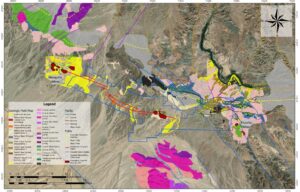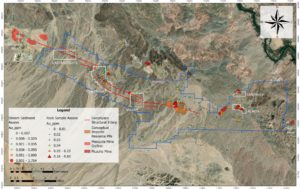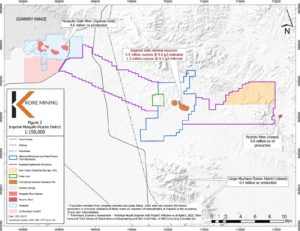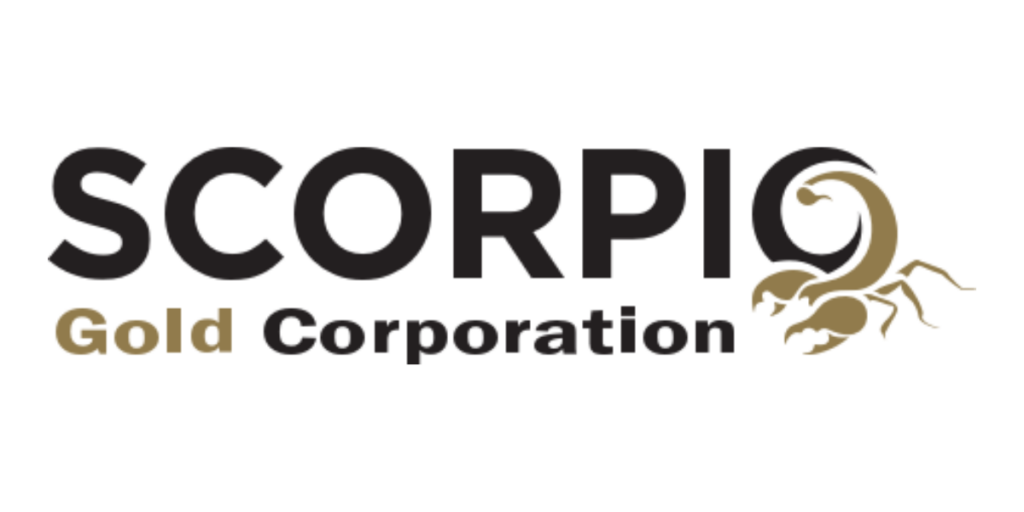Assays and Analyses Pending on Various Target Areas from 2021 Program
February 10, 2022 – KORE Mining Ltd. (TSXV: KORE | OTCQX: KOREF) (“KORE” or the “Company”) is pleased to announce a breakthrough year of exploration for the Imperial Gold project (“Imperial”), generating a step-change in geologic understanding and proving up exploration techniques. The successful 2021 exploration program is now complete with various assays and analyses pending. Exploration in 2021 focused on the Mesquite-Imperial-Picacho District (“District”), which captures 28 kilometers (“km”) of strike from Equinox Gold’s (TSX: EQX) operating Mesquite gold mine (“Mesquite”) to the historic Picacho gold mine (“Picacho”).
2021 Highlights and Achievements:
- Completed 100+ person-days of regional mapping and data compilation
- Incorporated 130,000+ acres of mapping and scientific data into regional geologic model
- Completed satellite alteration survey, generating eight new prospect areas
- Collected 552 soil and rock samples, generating wide ranging anomalous gold occurrences
- Discovered gold nuggets up to 4 millimeters (“mm”) in multiple prospect areas
- Increased mineralized strike length of the Powerline drill target to over 2km o Includes 0.53 gram per tonne (“g/t”) stream sediment sample
- Defined new drill target area Acacia which is currently over 1.0 km of mineralized strike
- Highlights from sampling include 1.0 g/t and 0.6 g/t gold
- Staked additional 6,350 acres of claims to capture further opportunities
- Permitted and trialled person-portable drill system to extend prospects under cover
- Ended year with five defined drill target areas with more assays and analyses pending
KORE’s CEO Scott Trebilcock commented, “The exploration team delivered a step-change in geologic understanding, a key step in unlocking the potential for the Mesquite-Imperial-Picacho District to host multiple gold discoveries similar to Mesquite and Imperial. The amount of outcrop, gold nuggets, and anomalous gold occurrence far exceeded our expectations. With a large number of pending assays and ongoing analyses, we expect more news in the coming weeks and months.”
2022 Plans and Objectives:
- Complete additional target definition drilling with person-portable drill
- Focus additional mapping and sampling on Powerline, Mesquite East and Ogilby targets to:
- Prioritize drill order for pending drill permit application (permit expected in H2 2022)
- Develop drill locations to support additional drill permit application in mid-2022
Complete infill IP geophysics program to refine fault and structural geologic models
KORE has now defined five high priority target zones on the District: Mesquite East, Ogilby, Powerline, Sandwich and Acacia zones which all lie along the regionally extensive Copper Basin thrust fault. Future sampling, mapping, scout back-pack drilling, geophysics and other exploration techniques are expected to further define these target areas with 141 assays pending from the lab.
Having the intact Imperial deposit to “tune” or “fingerprint” geophysical signatures, greatly enhances the Company’s confidence to target new discoveries under the alluvium along the trend. Details of the work were released January 7, 2020, April 29, 2020, December 8, 2020, April 13, 2021 and September 7, 2021.
KORE is committed to operating within the stringent environmental and labour standards of California.
Figure 1 shows the new geology model compiled from 2021 field work, scientific, and historic data.
Figure 2 shows the location of each named target area with all the rock chip and soil sampling data.
Figure 3 shows the District claim area with location of the Mesquite, Imperial and Picacho deposits along with the new claims staked in early 2021.
Sampling and Mapping Program Details
Discovery of gold in the dry stream beds (also called “arroyos” or “washes”) on the target areas are several kilometers from Mesquite, Picacho and/or Imperial and not downstream from any known deposits, indicating that gold is likely being generated from another source. KORE will identify the main sources by executing a detail sampling program directly on strike of the geophysical anomaly.
Interpretation of KORE’s recently completed satellite multi-spectral survey has identified additional alteration anomalies, many of which have yet to be mapped or tested. This is positive as it indicates the alluvial cover is shallow in those areas, making a new oxide gold discovery easier and more attractive. KORE also continues to find evidence of historic small scale mining activities in the District, including hand and bulldozer trenches and signs of historic placer mining activity.
In 2021, KORE’s exploration team collected 259 rock samples and 293 stream sediment samples. Samples collected averaged 4.0 kilogram in size and were taken at an average depth of 0.4 meters below surface. Of the 703 stream samples taken so far, 435 assayed over the gold detection limit of 5 parts per billion and 16 assayed over 100 parts per billion (0.1 g/t) with 24 samples still pending. In addition, of the 345 rock samples taken, 45 have assayed over 100 parts per billion (0.1 g/t) with 117 samples still pending. Sample locations and assays for the eastern area from Imperial to Picacho are depicted on Figure 2.
About the Imperial Gold Project
KORE owns 100% of the Mesquite-Imperial-Picacho District which consists approximately 31,000 acres of claims capturing the entire 28-kilometer trend from the operating Mesquite mine (Equinox Gold – TSX:EQX) to the closed Picacho mine and including KORE’s Imperial project as depicted on Figure 3. In the District, gold is hosted in local fault structures related to a series of regional faults connecting the known District deposits. Those three District deposits (Mesquite, Imperial and Picacho) were discovered in exposed outcrops and from placer workings. The rest of the District is covered by alluvium and has never been systematically explored.
The Mesquite-Imperial-Picacho District centers on KORE’s Imperial project. Imperial is a structurally controlled intermediate sulfidation epithermal gold deposit. The 100% oxide gold deposit is currently defined at 2.44 kilometer long and up to 0.75 kilometer wide and is open both along strike and downdip. It is hosted in a shallowly southwest dipping, amphibolite grade metamorphic rock suite along a west-northwest trending low-angle regional thrust fault system which controls the regional geometry of mineralization. East-west striking, post-mineralization normal faults control the property scale geometry of mineralization. Geophysical characterization of the deposit and regional controlling structures is an essential component of exploration for additional resources.
Imperial has a mineral resource estimate and a positive preliminary economic assessment effective April 6, 2020 with the following highlights:
- Robust economics: US$ 343 million NPV5% post-tax with 44% IRR at US$ 1,450 per ounce gold
- Low capital intensity project with only US$ 143 million pre-production capital cost
- Average 146,000 ounces gold per year over 8 years for 1.2 million ounces total production
- Technically simple project: shallow open pit, run-of-mine heap leach with existing infrastructure
- Value enhancement through Mesquite-Imperial-Picacho District exploration and resource expansion
The Company’s NI 43-101 compliant resource and preliminary economic assessment is titled “Preliminary Economic Assessment – Technical Report Imperial Gold Project” effective as of April 6, 2020 and revised and amended on June 10, 2021, prepared by Terre Lane and Todd Harvey of Global Resource Engineering and Glen Cole of SRK Consulting (Canada) Inc.
About KORE Mining
KORE Mining is focused on responsibly creating value from its portfolio of gold assets in California, USA. The Company is advancing the Imperial project towards development while continuing to explore across both district-scale gold assets. Management and Board, along with strategic investor, Eric Sprott (26% owner), are aligned with all KORE shareholders with the goal of creating per share value.
Further information on Imperial and KORE can be found on the Company’s website at www.koremining.com or by contacting us as info@koremining.com or by telephone at (888) 407-5450.
On behalf of KORE Mining Ltd
”Scott Trebilcock”
Chief Executive Officer
(888) 407-5450
Investor Relations
KIN Communications
1-888-684-6730
kore@kincommunications.com
Technical information with respect to the District and Imperial Gold Project contained in this news release has been reviewed and approved by Marc Leduc, P.Eng, who is KORE’s COO and is the qualified person under National Instrument 43-101 responsible for the technical matters of this news release.
Neither the TSX Venture Exchange nor its Regulation Services Provider (as that term is defined in the policies of the TSX Venture Exchange) accepts responsibility for the adequacy or accuracy of this release.
Cautionary Statement Regarding Forward-Looking Information
This news release contains forward-looking statements relating to the future operations of the Company and other statements that are not historical facts. Forward-looking statements are often identified by terms such as “will”, “may”, “should”, “anticipate”, “expects”, “intends”, “indicates” and similar expressions. All statements other than statements of historical fact, included in this release, including, without limitation, statements regarding the future plans and objectives of the Company are forward-looking statements.
Forward‐looking statements in this news release include, but are not limited to, statements with respect to: the strategy, timing and implementation of permit regional exploration drilling in the 28-kilometer Mesquite-Imperial-Picacho District (“Regional Exploration Drilling”) and permit drilling to advance the existing Imperial gold deposit (“Imperial Zone”) toward feasibility and mine permitting at the Imperial project; the timing of submitting Environmental Assessment report(s) for one or more areas of the Imperial project; potential actions, behavior or position of the Bureau of Land Management (the “BLM”); the underexplored and prospective nature of the Imperial Regional Exploration Drilling area; the results of the preliminary economic assessments for the Imperial Project, including future project opportunities, the projected NPV, permit timelines, the current mineral resource estimate, and the ability to obtain the requisite permits; the market and future price of and demand for gold; the opportunities of expansion at the Imperial Project; and the ability to work cooperatively with stakeholders, including all levels of government. Such forward‐looking statements, and any assumptions upon which they are based, are made in good faith and reflect our current judgment regarding the direction of our business. In connection with the forward‐looking information contained in this presentation, the Company has made numerous assumptions, including, among others: there being no significant change to current geotechnical, metallurgical, hydrological and other physical conditions at the Imperial Project; exploration, permitting, and development of the Imperial Project being consistent with current expectations and planning; the geological, permitting and economic advice that the Company has received is reliable and is based upon practices and methodologies which are consistent with industry standards; and other planning assumptions. While the Company considers these assumptions to be reasonable, these assumptions are inherently subject to significant uncertainties and contingencies.
Forward looking information involves known and unknown risks, uncertainties and other factors which may cause the actual results, performance or achievements of the Company to be materially different from any future results, performance or achievements expressed or implied by the forward‐looking information. Known risk factors include, among others: the outcome of BLM’s review processes for permitting, including the final outcome(s) of BLM’s mineral claim validity examination(s) and administrative review process(es) with respect to the Imperial Zone, including a change to the findings from the mineral claim validity examination conducted in 2002 for the mill sites at the Imperial Zone, resulting in the Company having to move its future Imperial Zone project support facilities to areas that
are not within the Indian Pass mineral withdrawal area; the possibility that BLM may require and/or conduct further mineral claim validity examinations with respect to the Imperial project, and the outcome and final determination of such examination could, among other things, invalidate one or more mining claims; the possibility that BLM or other governmental authority review of the Regional Exploration Drilling program, delays or changes the Company’s plan for Regional Exploration Drilling permitting, which could result, among other things, in delays, additional project requirements, additional costs and uncertainty of meeting anticipated program milestones; the exploration drill program may not be completed as planned; the need to obtain additional financing; uncertainty as to the availability and terms of future financing; the possibility of delay in exploration or development programs and uncertainty of meeting anticipated program milestones; uncertainty as to timely availability of permits and other government approvals.
Additional risks and uncertainties are described in the “Risks” sections of (i) the Company’s Annual Information Form for the year ended December 31, 2020 prepared as of April 29, 2021, and (ii) the Company’s Management’s Discussion and Analysis for the nine months ended September 30, 2021, both available under the Company’s issuer profile on www.sedar.com.
Forward-looking statements contained herein are made as of the date of this news release and the Company disclaims any obligation to update any forward-looking statements, whether as a result of new information, future events or results, except as may be required by applicable securities laws. There can be no assurance that forward-looking information will prove to be accurate, as actual results and future events could differ materially from those anticipated in such statements. Accordingly, readers should not place undue reliance on forward-looking information.
There is no certainty that all or any part of the mineral resource will be converted into mineral reserve. It is uncertain if further exploration will allow improving the classification of the Indicated or Inferred mineral resource. Mineral resources are not mineral reserves and do not have demonstrated economic viability.








